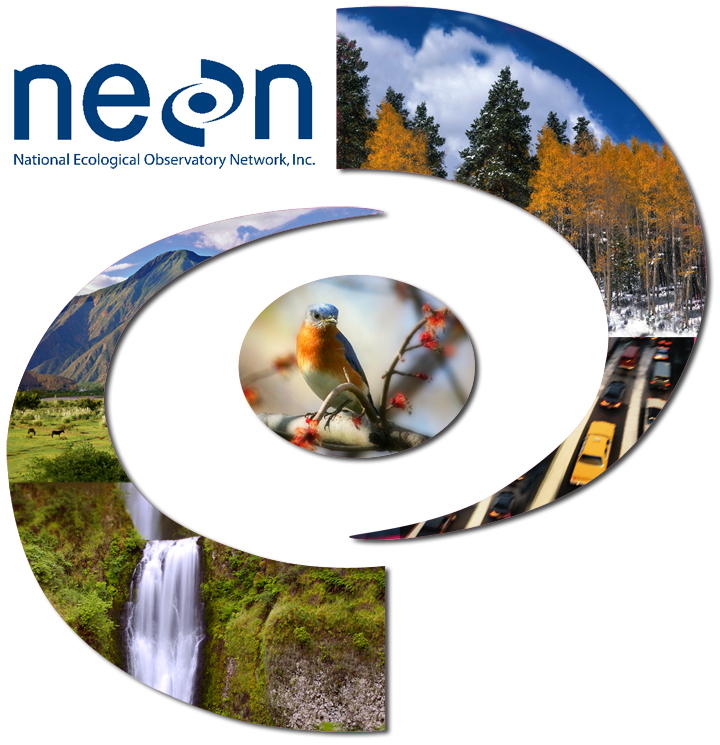A Bright Light for Ecological Research
After a decade of planning, the National Ecological Observatory Network (NEON) gets the green light to monitor the nation's ecosystems
WE ARE LIVING IN A TIME of unprecedented environmental change. Ecosystems face an onslaught of pressures being wrought by human land use and climate change – shifts in seasons, altered species distributions, the spread of invasive species and disease, insect outbreaks, and widespread extinction. Compounding the problem is humankind’s limited ability to adequately understand and predict these changes. But to a certain extent that is about to change after more than ten year’s worth of brainstorming, planning, evaluation, and reevaluation.
Creating big things can be a long and laborious process, and the National Ecological Observatory Network is big indeed. In fact, in a very real sense it is the ecological equivalent of a deep space telescope. When completed in 2016, NEON will be the National Science Foundation’s continental network of data-gathering stations funded to the tune of $433 million by the federal Major Research Equipment and Facilities Construction program – the same pot of money that has created several astronomical observatories as well as oceanographic vessels and other big-ticket items needed to advance science.
But unlike astronomers, notes Scott Ollinger of the Complex Systems Research Center, “Ecologists don’t need one big telescope, they need a large network of little ones because ecosystems are so complex and variable in both space and time. It is very difficult, for example, to say ‘this is the way a forest behaves’ even after the most intensive studies conducted at individual sites.”
So in order to see the forest for the trees NEON will build and link together 62 sites in 20 regional “domains” across the country and, for starters, make 270 crucial measurements in the surrounding ecological system.
In the Northeast, NEON sites will be built at the Bartlett Experimental Forest in New Hampshire’s White Mountains and, in Massachusetts, Harvard Forest in Petersham and a site in Burlington representative of urban land use. Measurements of plants, soils, organisms, and aquatic ecosystems will be collected using a multi-tiered approach involving instrument towers, distributed field plots, and aircraft remote-observation platforms that will collect state-of-the-art image data for the landscape surrounding each site.
Data for each site will be gathered in precisely the same fashion using precisely the same equipment over the same span of time. It will be the equivalent of hooking the U.S. landscape up to a giant vital functions monitor.
“NEON grew from the notion that understanding large-scale ecological problems requires a distributed network of sensors that will continually monitor the pulse, composition, and function of ecosystems around the country,” notes Ollinger, a terrestrial ecologist who has been involved in the planning of NEON from its early stages. The network will eventually provide scientists with the capacity to understand aspects of ecosystems that heretofore have been impossible through conventional, disparate approaches, and will allow for timely monitoring of large-scale changes in the environment.
For example, one of the important roles NEON will fill is keeping a finger on the pulse of ecological shifts wrought by climate change such as species distribution, biogeochemical cycles, and the spread of invasive species and vector-borne diseases.
“We don’t really have anything in place right now that would adequately detect these changes at the spatial and temporal scales over which they will occur,” Ollinger says. Indeed, currently, if there were a severe climate event that affected the entire country, it would take years to conduct a meaningful analysis and scientists would still gain only a limited picture of the effects on ecosystems. Data would have to be cobbled together from work being done by individual researchers scattered around the country. With the integration of measurements and open-data policy that define NEON, “we’ll be able to do meaningful analysis a week after such an event,” Ollinger notes.
NEON has passed all phases of scientific review and has been included in President Obama's FY11 Budget Request to Congress. Most recently, the National Science Board (the governing board for NSF and policy advisors to the president and Congress) authorized the NSF director to issue a five-year award to NEON, Inc. for the construction of the network. But it will still be awhile before the “instant” big-picture ecological views are available. Any such award is contingent upon approval and appropriation by Congress and on NSF completing its Endangered Species Act and National Historic Preservation Act compliance for each of NEON sites. Should those remaining hurdles be cleared it will take five years of construction to complete the 62-site network.
Ollinger was part of the NEON design consortium, served on the NSF panel that reviewed the network, and now serves on the board of directors of NEON, Inc., the nonprofit corporation NSF established to implement and maintain the network. Additionally, John Aber (formerly of CSRC and now UNH provost) and associate professor Serita Frey of the Department of Natural Resources and the Environment have also played an active role in the planning process. “UNH is a founding member of NEON and has been involved as much as any university pretty much from day one,” Ollinger says.
As the name implies, the Complex Systems Research Center is no stranger to probing the intricacies of vastly complicated, interconnected environments, including those on regional and continental scales.
But because NEON represents such a new tool for the field of ecology, the NSF recently announced the creation of a new program entitled “Macrosystems Biology: Research on Biological Systems on Regional to Continental Scales” to stimulate the kinds of research NEON will support.
Of the new program Ollinger says, “It’s a call for proposals to get people thinking along the right lines and used to the concept of continental scale ecology. NSF is willing to grease the skids a bit by putting money upfront to stimulate that kind of research. To me that’s a good sign of their long-term commitment to large-scale biology.”
In other words, when the NEON network switches on sometime in 2016 researchers will be able to hit the ground running with the rich dataset that will begin to flow immediately. The network is slated to take the pulse of the landscape continuously for a minimum of 30 years.
For more information visit NEON and NSF.
 |
But unlike astronomers, notes Scott Ollinger of the Complex Systems Research Center, “Ecologists don’t need one big telescope, they need a large network of little ones because ecosystems are so complex and variable in both space and time. It is very difficult, for example, to say ‘this is the way a forest behaves’ even after the most intensive studies conducted at individual sites.”
 | |
| NEON will build and link together 62 sites in 20 regional "eco-climatic domains" across the country. Photo courtesy of NEON. |
In the Northeast, NEON sites will be built at the Bartlett Experimental Forest in New Hampshire’s White Mountains and, in Massachusetts, Harvard Forest in Petersham and a site in Burlington representative of urban land use. Measurements of plants, soils, organisms, and aquatic ecosystems will be collected using a multi-tiered approach involving instrument towers, distributed field plots, and aircraft remote-observation platforms that will collect state-of-the-art image data for the landscape surrounding each site.
 | |
| Harvard Forest, Petersham, Mass. | |
 | |
| Bartlett Experimental Forest in New Hampshire's White Mountains Photo courtesy of U.S. Forest Service. |
“NEON grew from the notion that understanding large-scale ecological problems requires a distributed network of sensors that will continually monitor the pulse, composition, and function of ecosystems around the country,” notes Ollinger, a terrestrial ecologist who has been involved in the planning of NEON from its early stages. The network will eventually provide scientists with the capacity to understand aspects of ecosystems that heretofore have been impossible through conventional, disparate approaches, and will allow for timely monitoring of large-scale changes in the environment.
For example, one of the important roles NEON will fill is keeping a finger on the pulse of ecological shifts wrought by climate change such as species distribution, biogeochemical cycles, and the spread of invasive species and vector-borne diseases.
“We don’t really have anything in place right now that would adequately detect these changes at the spatial and temporal scales over which they will occur,” Ollinger says. Indeed, currently, if there were a severe climate event that affected the entire country, it would take years to conduct a meaningful analysis and scientists would still gain only a limited picture of the effects on ecosystems. Data would have to be cobbled together from work being done by individual researchers scattered around the country. With the integration of measurements and open-data policy that define NEON, “we’ll be able to do meaningful analysis a week after such an event,” Ollinger notes.
NEON has passed all phases of scientific review and has been included in President Obama's FY11 Budget Request to Congress. Most recently, the National Science Board (the governing board for NSF and policy advisors to the president and Congress) authorized the NSF director to issue a five-year award to NEON, Inc. for the construction of the network. But it will still be awhile before the “instant” big-picture ecological views are available. Any such award is contingent upon approval and appropriation by Congress and on NSF completing its Endangered Species Act and National Historic Preservation Act compliance for each of NEON sites. Should those remaining hurdles be cleared it will take five years of construction to complete the 62-site network.
 |
|
| |
As the name implies, the Complex Systems Research Center is no stranger to probing the intricacies of vastly complicated, interconnected environments, including those on regional and continental scales.
But because NEON represents such a new tool for the field of ecology, the NSF recently announced the creation of a new program entitled “Macrosystems Biology: Research on Biological Systems on Regional to Continental Scales” to stimulate the kinds of research NEON will support.
Of the new program Ollinger says, “It’s a call for proposals to get people thinking along the right lines and used to the concept of continental scale ecology. NSF is willing to grease the skids a bit by putting money upfront to stimulate that kind of research. To me that’s a good sign of their long-term commitment to large-scale biology.”
In other words, when the NEON network switches on sometime in 2016 researchers will be able to hit the ground running with the rich dataset that will begin to flow immediately. The network is slated to take the pulse of the landscape continuously for a minimum of 30 years.
For more information visit NEON and NSF.
by David Sims, Science Writer, Institute for the Study of Earth, Oceans, and Space. Published in Summer 2010 issue of EOS .
